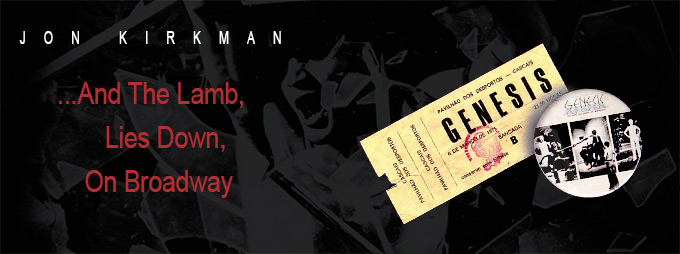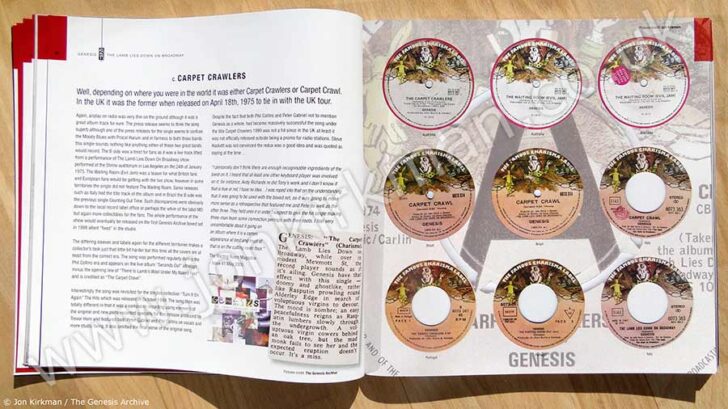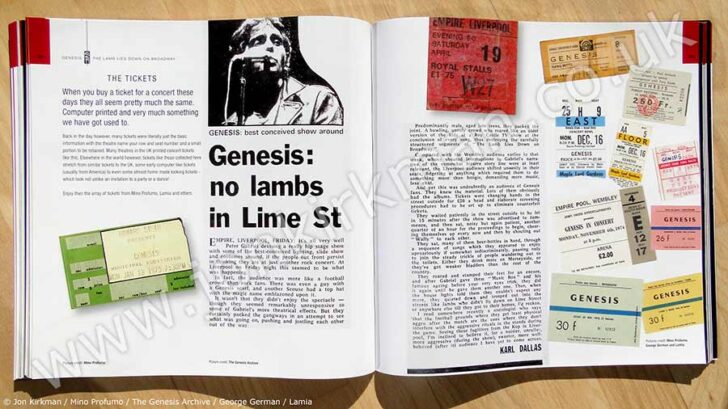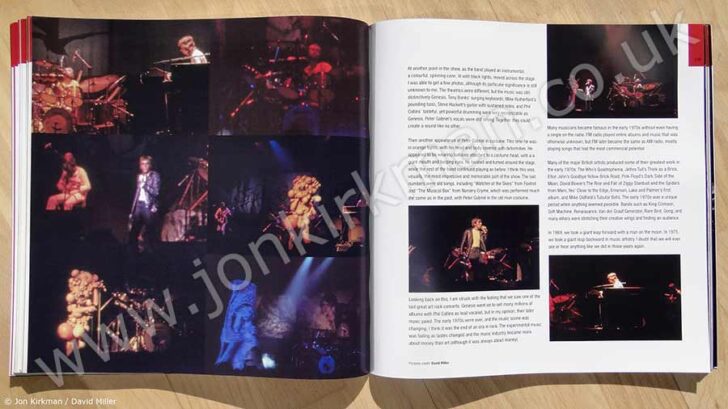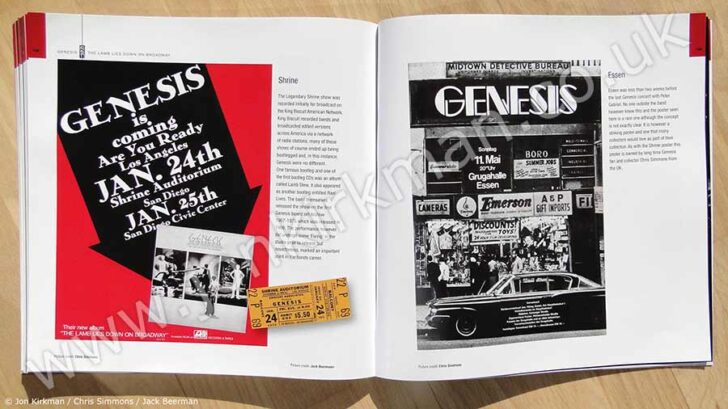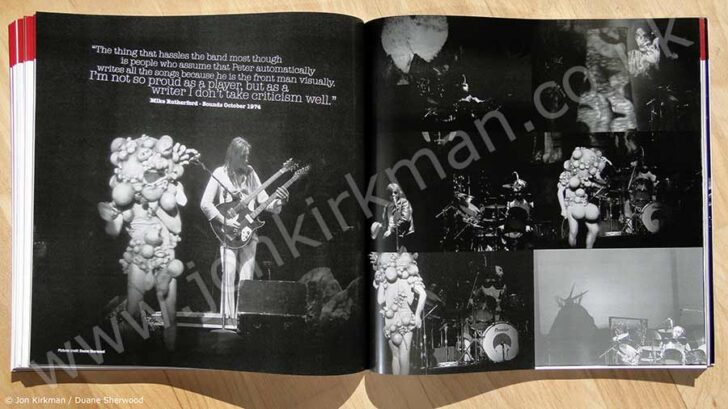- Article
- Read in 13 minutes
Jon Kirkman – …And The Lamb, Lies Down, On Broadway – book review
In early 2019, the long awaited book about The Lamb Lies Down On Broadway by Jon Kirkman, has finally been made available to fans. Martin Klinkhardt took a closer look.
“This new book takes a very detailed look at this particular period in the history of Genesis [i.e. the time in which Genesis wrote and toured with The Lamb]. Through the bringing together of many rare photographs, memorabilia, recollections from people in the audience, band members, designers, photographers and crew the book brings this largely undocumented tour to light in impressive style.”
When a book about the Lambperiod is advertised in terms like those it is bound to awaken pretty great expectations along the line of, say, the Lambshows by The Musical Box combined with the insights from Chapter & Verse, the scholarly knowledge from Kevin Holm-Hudson’s book and the immense and intricate knowledge of fans like Serge Morrissette who research their information into the most minute details … No book can even begin to rise to expectations like that. So let us put aside what I expect from the book and check out what Jon Kirkman really gives us.
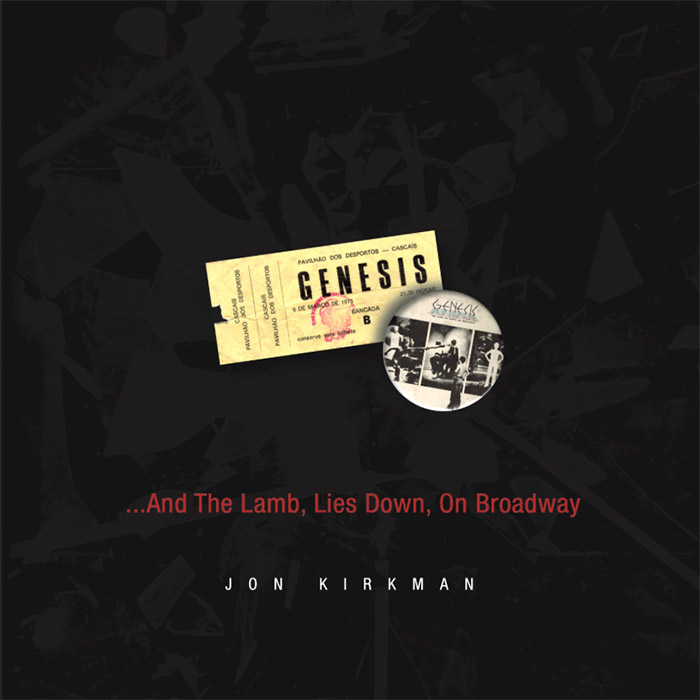
The black cover of a large format book (30x30cm, 1sqft, or simply, LP cover size) sports a ticket for the Lamb show at Cascais, Portugal (March 06, 1975) and a Lamb button as eye-catchers. Below those there is the title, “… And The Lamb, Lies Down, On Broadway” (sic!), and Kirkman and his proof-reader must have fought nail and tooth about those colons. They may or may not refer to the phrasing of the lyrics as they were sung; there is no space for footnotes on the title page. It takes a closer look to realize that the cover is not simply all black, but features that image of Rael in the shattering mirror (or is it supposed to be the “wall of death”?). All in all, an attractive cover.
Kirkman uses the introduction to run the history of The Lamb Lies Down On Broadway from its conception to the end of the tour by us before he gives his mission statement: This is not the book that tells the definitive true story of The Lamb; it aims at a colourful panoramic view of that period with lots of memorabilia, memories of Steve Hackett and Tony Banks and the input from people who stood at the sidelines of the story such as Mike Rutherford’s guitar roadie Dale Newman, Hipgnosis cover designer Aubrey Powell and a number of people from Genesis’ road crew on the Lamb tour. Additional material comes with the memories various fans have of the Lamb shows. The “thank you” list and the picture credits show the essential role the “hunters and gatherers” among the fans played in the creation of the book.
The introduction is somewhat extended by Jordan Blum’s essay The Light Won’t Die Down On Broadway. Unusually for the beginning of a book, it discusses the life of The Lamb, as it were, after the end of the tour. Blum starts off with Steve Hackett’s idea that bands like ELO and Pink Floyd drew inspiration from the Lambalbum. He then proceeds to detail how central elements of the music and its live performance have affected prog and neo-prog musicians such as Steven Wilson and Franck Carducci. He cites mainly members of Spock’s Beard, which is fine seeing as Nick d’Virgilio, singer with Spock’s Beard, has recorded his version of the whole Lambalbum (Rewiring Genesis). There are some noteworthy insights beyond all the excitement, e.g. that The Lamb, which is considered a milestone in prog music, actually manages to avoid most characteristics of “typical” prog songs. Every in the essay agrees that the actual story of Rael was as important for the impact of the album as the music, that Gabriel’s lyrics and the music the other four band member wrote complemented each other in a way only this band could do it at that precise and pivotal moment in its history.
The first chapter … actually, the chapters given in the table of contents are not really chapter headings, but pointers to the tune of “go here if you want to find something about…” So, the first chapter beings with a brief interview that has Steve Hackett looking back at the time when Genesis were working on their new album at Headley Grange. It does not reveal anything new, really, but it describes the mood in the band and the atmosphere both at Headley Grange and Glaspant Manor, where Genesis would record the music.
Aubrey Powell talks about how the artwork for The Lamb was developed from many single ideas, a general idea and countless photos. He also reveals that, sadly, hardly anything from the preparatory works and photos and montages has survived – except for, apparently, the pristine original of the album cover.
Tony Banks was interviewed about The Lamb Lies Down On Broadway in the anniversary year 2014. The transcript offers hardly anything new; the only thing that is interesting is Tony’s answer to the question why so many people would like to see a re-formed Genesis do The Lamb in particular.
Ant Phillips points out in his interview with Jon Kirkman that Peter Gabriel was not the only one to sort of leave the band during the Lamb period: Before and after the Lamb tour Mike Rutherford and Phil Collins worked on an album of Anthony Phillips’ that would only come out in 1977 due to the repercussions of Peter leaving the band: The Geese And The Ghost. The interview shows Ant’s excellent perspective: He was close to the band but he had enough distance to see the bigger picture, as it were. The very thought that The Lamb and The Geese developed simultaneously with almost the same musicians and still turned out to differently is worth meditating on.
With this, the book turns to the release history of the album. Essential information for individual releases is accompanied by a flood of images (sleeves, singles, advertisements, reviews). Counting Out Time is first. Second is a little-known acetate, the so-called Genesis Christmas Acetate. Discussion of the Carpet Crawlers single leads to the 1999 recording of the song, and Steve Hackett feels strongly about that. The single for The Lamb Lies Down On Broadway shifts the focus to the whole album and its live performance.
After a few introductory words, Alan Hewitt gets to solve the “mystery” of the Lambtour and provide the “definitive” list of the Lambtour dates. However, the Wiesbaden show did not take place on May 12, 1975, but two days later, and the Munich show was moved to Rudi-Sedlmayer-Halle. But this cannot be held against Kirkman at all, of course.
The book approaches the Lambtour from the outside, from the preliminary groundwork. Speaking with Jon Kirkman, Colin Richardson, then manager with Charisma Records remembers the tour he accompanied with press and promotion work. He had worked with Genesis since the Charisma package tour. Richardson considers it an advantage that The Lamb was hard to get into: “It was almost as though the audience felt, ‘This is amazing, they’re challenging me, I will rise to the occasion.’” (p.65)
Friction in the band was something he hardly noticed, though he remembers very keenly the dressing down he received from Tony Banks when he had the impression other bands got more promo. Richardson accompanied the band mainly on their German shows and adds a few spicy anecdotes about how Peter had his makeup applied before the shows and the infamous tantrum Mike Rutherford threw in an Italian hotel.
Several pages of the book are dedicated to various Genesis Lamb show concert posters; most of those come from Mino Profumo’s collection. For David Lawrence the Lamb tour was his first outing as a roadie; the book offers his report (which was previously published on the English website The Waiting Room) where he tells of the hard work and sundry grotesque moments on tour. Lawrence’s report is framed by a collection of backstage, press and photo passes, most of which come, again, from the collection of Mino Profumo.
Dale Newman’s memories of the Lambtour illustrate why work as a roadie was really hard at the time, though it apparently also had its funny moments. He suspects that he was the very last person to find out – long after the end of the tour – that Peter Gabriel had left the band.
If you wonder what concert contracts used to look like in the mid-1970s you can check out reproductions of the documents covering the performance at Colston Hall, Bristol, UK. A variety of tickets (courtesy of the collections of Mino Profumo, George German and ‘Lamia’) takes the reader back to the time before tickets were standardized and came out of a printer. The tickets surround a contemporary review of the Lamb show at the Empire, Liverpool (basically: “The music and the show were good, but the audience did not appreciate that.”)
After so many reports and interviews with the band and their crew the book gives the word to those who listened to the music and came to see the show. A number of memories of the shows in Rochester, NY (Dec 17, 1974), Berkeley (Jan 22, 1975) and Southampton, US (April 16, 1975) – concerts early, middle and late in the tour – have been selected as representatives for the fans and concert-goers of those years. David Miller had only a few iconic images still in his mind: Gabriel as a punk in a leather jacket, the Slipperman costume, the Lamia cone. The patently incomplete has the charme of authenticity.
Duane Sherwood’s report from the Rochester, NY, show, focuses on the musical impressions, but also recalls a slideshow without problems and the blindingly white light during The Waiting Room. His impression that the album had come out “a few months” before the show (U.S. release date was between Nov 25 and 29, 1974 – see also our article about the release date research of that album) is somewhat misleading, but certainly just one of the tricks our memories like to play with us. Sherwood has taken a series of fine black-and-white pictures that appear in the book.
Nigel Leppard’s report uses an almost “unlistenable bootleg” from the Southampton concert to boost his memories. He is very eloquent about perplexed the fans were at the visual elements of the show, even at point where they were familiar with the music.
Steve Hackett’s second interview in the book picks up where the first left off. It begins with the infamous broken wineglass that pushed the UK leg of the tour towards the end. Hackett insists that his injured hand was only the official reason and that the postponement had a number of reasons. Asked about the goal Genesis wanted to achieve beyond all artistic ambition, he puts it very concisely: “We weren’t thinking of longevity … we hoped the record company would renew our recording contract” (p.148) Hackett also mused on how much the way musicians – or, at least, himself – throw themselves into work and wear themselves out doing music has changed in the last decades. The interview also covers the singles and the final Lamb show as well as parallels with the almost simultaneous concept albums by Yes and Jethro Tull as well as potential new performances of The Lamb. Hackett’s take on the Lamb album is differentiated; in his words the band new that this big change meant everybody had to adapt their role: “Peter was very much the star of the band and his performance was reviewed quite differently from the rest of [the band]. When Pete left it was a different story … it was a case of, if not wiggling the bum but showing a little more thigh perhaps” (p.153/155)
Another series of statements from fans and how they experienced the Lamb shows marks the end of the book as far as it concerns the years 1974 and 1975. Some of them provide not just text, but series of photos, which gives the reader a variety of impressions. The recollections mention the tense concentration with which they attended the shows, the overwhelming effect, the problems that plagued the visual side of the show, the frequently brilliant sound – and, interestingly, repeatedly mention that Collins’s drumming was perceived as the element that organized the show and drove it forward.
No consideration of the longevity of The Lamb Lies Down On Broadway can be complete without at least mentioning a certain Canadian band who have played The Lambat least four times as often as Genesis themselves. The Musical Box are famous for their most faithful reproductions of the Genesis tours up until the Trickshow. The received their accolade from Genesis in February 2005 when – on a concert of their own Lamb Lies Down On Broadway tour – Phil Collins guested as a drummer for the encore song of The Musical Box. The band’s singer, Denis Gagné, talks about the immense effort that went into the reconstruction of the stage and the props. What is even more interesting is what he tells about the demands a staging of The Lamb makes on the singer. In order to play Peter Gabriel playing Rael, you have to have a strong voice on stage and be very quick offstage. Plus he also nixes the theory that everything works better these days: “Many things are of the same kind of stuff that [Genesis] used, especially for instruments … The only difference is that the ones we use are fourty years older than the ones they had – so our stuff is probably less reliable…” (p.175)
The British Genesis cover band The Carpet Crawlers are perhaps less well-known internationally. The fact that they, too, have played the entire Lamb show on two long tours and released CDs and DVDs of it, is probably even more obscure knowledge (though the band is absolutely worth knowing and seeing!). Brian Cummings, the head Carpet Crawler, tells Kirkman how the band started out with shows that presented music from all of Genesis’ releases and slowly worked their way up to a specific Lamb show. He is full of praise for the support they had in recreating props like the Slipperman and the Lamia cone. Cummings is amazed to this day just how much Genesis challenged their audiences with that heady combination of a sparse stage action, sophisticated music and the rich visual effects from slide shows to weird props – not your average “let’s hear some music and have a good time” evening, but an art event that demanded (and got!) the audiences utter concentration. While The Musical Box’s Denis Gagné has more or less ruled out that they will ever do The Lambagain, The Carpet Crawlers poetically state that they have found a fine warm barn for the Lamband may take it out again some time.
A selection of concert posters and some more of Duane Sherwood’s fine black-and-white photos of a Lamb show bring the reader back to reality. This is it.
Unfortunately, one of the drawbacks of this book is the lack of proof-reading. Whether you decide to keep meandering run-on sentences in interview transcripts or not is a question of taste and philosophy. That’s not for me to criticize, and it’s not my point. But this book has a word missing every now and then, sometimes a letter, sometimes words are redundant. In the interview with Tony Banks there even is a paragraph printed twice in a row. Speaking of images, most are beautiful and well-chosen, but there are pixel artefacts. Kirkman could, perhaps, not get better digitalisations of the material in some cases, depending on the technical capabilities of the donating collector. But were there really no scans available of the four sides of the album artwork without such extremely visible artefacts, particularly when they were included in full-size format?
The website promised a detailed look at the time of the development and the live performance of The Lamb, with memories of people from the audience, designers, photographs, the band itself and their crew. And with many rare photos and collector’s items. And this is definitely what we get. The book covers events from more than 40 years ago. Therefore it does not matter that large parts of the interviews and the text were written around the 40th anniversary of the album release, i.e. from 2013/14. This book is no encyclopaedia of the Lamb era; it does not claim absolute accuracy (though I must say I do demand that as far as the list of tour dates is concerned, particularly when its author raises that claim). Jon Kirkman gives us a huge, colourful panoramic view of the Lamb era. Some things we know, others are new; I would like to draw attention to the new perspectives the interviews with Aubrey Powell, Ant Phillips and both tribute band singers provide.
The picture material chosen is impressive; obviously even for a book as lavishly pictured as this the author had to pick and choose, but another selection of photos would probably have been equally good – and equally incomplete. The constant switch between text and images keep this book very entertaining. Whether this book is worth the steep price (especially for the hardcover version) is up to you.
The large-size (30x30cm, 197 pages) book …And The Lamb, Lies Down, On Broadway by Jon Kirkman has come out in two versions:
– Softcover, 75 GBP
– Hardcover signed by Jon Kirkman and Steve Hackett, 150 GBP
You can order the book via the author’s website.
by Martin Klinkhardt, Februar 2019

